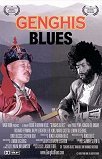
This record is a major signpost along a journey that began more than a
decade ago, when Paul Pena — a blind bluesman of Cape Verdian extraction living in
San Francisco — was searching the bands of his shortwave radio for a Korean language
lesson when he happened upon a strange oscillation. Squeaks and howls are common to
shortwave radio, but this particular oscillation was a melody! Here's the story in Paul's
own words:
Once Upon A Time
by Paul Pena
Once upon a time, back in 1984 or so, I was captivated by a program dealing with the
ethnic musics of the Soviet Union as presented on the English language broadcasts of Radio
Moscow. On this particular program they played a piece from a country whose name I
couldn't quite catch, reputed to be somewhere in Asia. It consisted of a man singing some
words and then singing a phrase of sygyt, a form of h��mei (throat singing), in which a
soloist sings two notes at once. (I later found out that "h��mei," which in
this case meant the whole phenomenon of throat singing, can also mean a particularly
eloquent style with which it is possible to work three notes at once: a fundamental drone,
a middle harmonic for rhythm, and a high harmonic, used for the melody of the phrase.)
Anyway, back to the story at hand. For about five years I was stumped by a simple and,
I believe, unintentional case of mis-communication (I thought the name of the country was
"Tuvash"), which caused me no end of trouble in trying to find out how such an
unusual form of singing was accomplished. I am, however, a rather cussed person, and one
day I happened into a record store to get something else. Something made me ask the man if
they had anything on harmonic singing, as throat singing is sometimes called. He replied
that they had one CD of music from "Tava" that might fit the bill. He fished it
out of the bins and said it was called "Tuva: Voices from the Center of Asia." I
must have looked kind of stunned for a few seconds, but then I did a squall and dance like
a four-year-old who has just had a best dream come true, and bought the disc.
After playing the CD continuously for several months and driving many of my friends
away by making weird noises while experimenting with my voice, I finally learned a few of
the basic techniques of this fascinating group of vocal styles by remembering the styles
of some of the blues greats of the past — especially Charlie Paton, Tommy McClennan,
and Chester "Howlin' Wolf" Burnett.
I give this background information in order to try and make it clear just how I felt
when I was told by a stranger at a club in San Francisco that some Tuvan h��mei singers
would soon be performing close enough to where I live so that I could attend.
However, so many people went to the Asian Art Museum that Saturday afternoon in
February of 1993 to hear the Tuvans (who had just been on a local radio show that morning)
that museum officials stopped selling tickets to the public. There was a woman in front of
me who must have seen how devastated I was at such news, because she gave me her best
quality ticket for the performance. And a kind gentleman who saw my enthusiasm for the
Tuvans, once I was inside the building, helped me get close enough to them so that I could
sing them a popular Tuvan song in the low, subharmonic kargyraa style, which is most
revered by Tuvans. I do not remember the gentleman's name, nor that of the generous lady
who gave me her ticket, but I would here like to express my sincere gratitude to these two
good people for their help.
One of the Tuvan singers, Kongar-ol Ondar, was especially friendly to me. As I look
back on the intervening time since that day, it seems almost inevitable that we would
combine our talents at some time in some way. On the other hand, if you had told me on the
day that I met Mr. Ondar that we would be performing together one day, and that I would
even have the honor of recording with him, I would have done my best to see to it that you
were made as comfortable as possible in the best home for the insane that I could find.
Seriously, though, this has been one of the most fulfilling things I have ever been
part of in my life, and I am truly honored to be a part of bringing this music to you.
Kongar-ol and I have been working in the hope of promoting better understanding between
people of different nationalities, races, beliefs, languages, and cultural and economic
systems. I believe that in this work there can be found evidence that such understanding
and cooperation can be realized.
In the further hope that you all will enjoy this music at least half as much as I have
enjoyed being a part of bringing it to you,
I am yours truly,
Paul Pena
San Francisco
October 1, 1994
Postscript: Paul went on to compete in UNESCO's Second International Festival
and Symposium of Throat-Singing, held in Kyzyl, Tuva's capital, in June, 1995. Despite
dozens of Tuvans competing, as well as participants from several foreign countries, Paul
won first place in the kargyraa division, and also received a special award for audience
favorite.
The award-winning film Genghis Blues is now showing in theatres, and will eventually
become available on video and DVD. For information, please visit www.GenghisBlues.com or contact Friends of Tuva,
Box 182, Belvedere CA 94920 USA.
To the next page or back to the Genghis Blues Lyrics Page.


